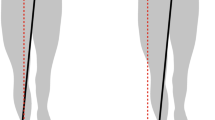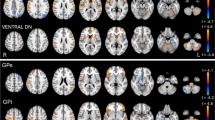Time series analysis methods were used to identify the characteristics of motor system activity to obtain objective assessments of the functional state of the pyramidal and extrapyramidal systems in humans. Voluntary control of isometric force as the motor output of a control system was used as a model of movement. An original noninvasive study methodology was used to measure isometric force as the motor output of the integrative activity of the CNS, along with contemporary time series analysis methods; these yielded new data for assessment of the activity of motor system structures in health and in a variety of neurodegenerative diseases of the CNS (Parkinson’s disease, multiple sclerosis), supplementing existing fundamental concepts in motor physiology and extending the potential of instrumented diagnosis of neuromotor dysfunctions.
Similar content being viewed by others
References
Z. A. Aleksanyan and S. P. Romanov, “Assessment of the integral activity of the human motor system in voluntary isometric contraction of the upper limb muscles,” Novosti Med.-Biol. Nauk. (Minsk), No. 1–2, 92–103 (2009).
N. A. Bernshtein, The Construction of Movements, Medgiz, Moscow (1947).
A. A. Zhiglyavskii and V. N. Solntsev, “The ‘caterpillar’ method: description of the algorithm,” D. L. Danilov and A. A. Zhiglyavskii (eds.), Izd. SPbGU, St. Petersburg (1997), pp. 9–18.
A. M. Ivanitskii, “The cerebral basis of subjective experiences: an information synthesis hypothesis,” Zh. Vyssh. Nerv. Deyat., 46, No. 2, 241–252 (1996).
A. M. Ivanitskii, V. B. Strelets, and I. A. Korsakov, Information Processes in the Brain and Mental Activity, Nauka, Moscow (1984).
M. E. Ioffe, “Cerebral mechanisms of formation of new movements during learning: evolution of classical concepts,” Zh. Vyssh. Nerv. Deyat., 53, No. 1, 5–21 (2003).
M. E. Ioffe, “Structural organization of motor control,” in: Neurodegenerative Diseases: Basic and Applied Aspects, M. V. Ugryumov (ed.), Nauka, Moscow (2010), pp. 36–39.
G. N. Kryzhanovskii, Parkinson’s disease (Etiology, Pathogenesis, Clinical Features, Diagnosis, Treatment, Prophylaxis), Meditsina, Moscow (2002).
S. V. Medvedev, T. Yu. Skvortsova, and R. N. Kraskikova, PET in Russia: Positron Emission Tomography in Clinical Practice and Physiology, Astrel, St. Petersburg (2008).
S. P. Romanov, “Conceptual approaches to the detection of the function of the structural organization of neural was,” Zh. Vyssh. Nerv. Deyat., 50, No. 2, 320–343 (2000).
S. P. Romanov, “Synaptic transformations and the function of the structure of connections of organized neural networks as the basis of the adaptive regulation of organ systems and the behavior of the body,” in: Neurocomputers in the Intellectual Technologies of the 21st Century, Yu. I. Nechaev (ed.) (2012), pp. 324–344.
S. P. Romanov, Z. A. Aleksanyan, and E. B. Lyskov, “Characteristics of the age dynamics of motor system activity in humans,” Fiziol. Cheloveka, 33, No. 4, 82–94 (2007).
S. P. Romanov, Z. A. Aleksanyan, E. B. Lyskov, et al., “Correlates of the parameters of voluntary force in the functional state of the motor system,” Ros. Fiziol. Zh., 91, No. 5, 488–501 (2005).
S. P. Romanov, M. G. Pchelin, and A. F. Yakimovskii, “Characteristics of recorded isometric tremor in lesions of the extrapyramidal system,” Ros. Fiziol. Zh., 83, No. 3, 133–139 (1997).
S. P. Romanov, A. F. Yakimovskii, and M. G. Pchelin, “A tensometry method for quantitative assessment of tremor,” Ros. Fiziol. Zh., 82, No. 2, 118–123 (1996).
I. M. Sechenov, Cerebral Reflexes (1863), Priboi, Leningrad (1926).
M. V. Ugryumov, “Traditional and novel concepts of the pathogenesis, diagnosis, and treatment of neurodegenerative diseases,” in: Neurodegenerative Diseases: Basic and Applied Aspects, M. V. Ugryumov (ed.), Nauka, Moscow (2010), pp. 8–35.
E. V. Ewarts, “Cerebral mechanisms of movement,” Vestn. LGU, No. 21, 88–97 (1974).
E. V. Ewarts, “Cerebral mechanisms controlling movements,” in Brain, P. V. Simonov (ed.), Mir, Moscow (1982), pp. 199–217.
N. Golyandina, “On the choice of parameters in singular spectrum analysis and related subspace-based methods,” Statist. Its Interface, 3, No. 3, 259–279 (2010).
S. P. Romanov and M. G. Pchelin, “The motor control output forming in healthy subjects and parkinsonian disorders patients,” in: Basal Ganglia and Thalamus in Health and Movement Disorders, K. Kultas-Ilinsky and I. A. Ilinsky (eds.), Kluwer/Academic/Plenum Press, New York (2001), pp. 293–305.
Author information
Authors and Affiliations
Corresponding author
Additional information
Translated from Rossiiskii Fiziologicheskii Zhurnal imeni I. M. Sechenova, Vol. 98, No. 11, pp. 1416–1431, November, 2012.
Rights and permissions
About this article
Cite this article
Aleksanyan, Z.A., Romanov, S.P. Measures of the Integrative Activity of the Motor System in Health and Pathological Neuromotor States. Neurosci Behav Physi 44, 793–803 (2014). https://doi.org/10.1007/s11055-014-9986-2
Received:
Published:
Issue Date:
DOI: https://doi.org/10.1007/s11055-014-9986-2




